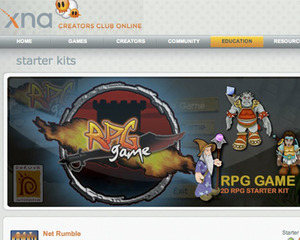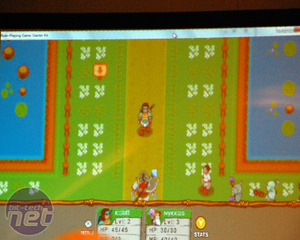
XNA examples and development
Microsoft offers multiple game ‘starter kits’ to download, with full, transparent source code – this means you can see exactly how key mechanics such as combat, exploration and inventories are handled. He first showed off Robot Game, which featured surprisingly creditable 3D graphics and big robots shooting each other. This was followed by RPG Games, a Zelda like overhead RPG title, complete with Final Fantasty style turn-based party versus party combat.Even to non-coding types such as ourselves, XNA looked surprisingly approachable. It’s not just coding that’s easy – publishing to a large audience is, too. Williams characterised Xbox Live Indie Games as “the first time a small, independent developer, not part of a studio, can develop for a full-on home console.”
All Xbox Live Indie Games titles are play-tested and peer-reviewed by the XNA Developer Community before appearing on Xbox Live, with five positive peer reviews required. Most games don't get through on the first go, and the peer reviewers are tough: Williams cited the Evil Checklist, which all games must conform to. Developers have to obey Microsoft's content policies, which Williams summed up as “no porn, no pipes, no poop, no plagiarism” - no sexual, drug or tobacco references, no bodily fluids, and no mucking with other peoples' stuff, basically.


Microsoft offers free downloadable starter packs that show how to make a generic game in multiple genres
Once on the Xbox, developers set their own price on a sliding scale of Microsoft Points, either 80 (~ $1), 240 or 400; Microsoft takes a 30 per cent cut.Games on Xbox Live Indie Games have a fixed eight minute demo period, and Williams stressed that this puts the onus on developers to make that eight minutes exciting: games that dump new players into an eight minute tutorial session are unlikely to sell well.
 According to Williams, currently, XNA feels like a hobbyist scene, but this is set to change in the next few weeks with the release of XNA 4.0, which will be more studio-friendly. It also (somewhat sneakily) pulls XNA support from Zune, effectively ending its life as a gaming platform. The next generation of XNA will bring some exciting changes, including more multi-touch controls and access to Xbox Live. Previously this has been denied to Indie developers out of fear that they would create Gamerscore-cranking apps to artificially scale the online leaderboards.
According to Williams, currently, XNA feels like a hobbyist scene, but this is set to change in the next few weeks with the release of XNA 4.0, which will be more studio-friendly. It also (somewhat sneakily) pulls XNA support from Zune, effectively ending its life as a gaming platform. The next generation of XNA will bring some exciting changes, including more multi-touch controls and access to Xbox Live. Previously this has been denied to Indie developers out of fear that they would create Gamerscore-cranking apps to artificially scale the online leaderboards. The degree of access is currently unknown, but all the signs are that Microsoft is increasingly seeing the value of making its platforms appealing to bedroom coders and indie developers.
if you're interested in taking a look at developing your own game, then bear in mind much of what was discussed in Williams' talk was free; his final slide also provided lots of interesting links, and you can see it to the right. Click to enlarge for a bigger version of it. Interested in coding your own games? Is multi-touch really the future? Let us know your thoughts in the forums.

MSI MPG Velox 100R Chassis Review
October 14 2021 | 15:04









Want to comment? Please log in.